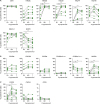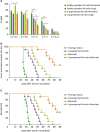INTRODUCTION
MATERIALS AND METHODS
Ethics statement
NK cell enrichment, expansion, and cryopreservation
Human cell lines
Immunostaining and flow cytometric analysis
Fluorometric cytotoxicity assay
Intracellular cytokine and CD107a staining
In vivo animal model of hepatocellular carcinoma
In vivo animal model of lymphoma
Statistical analysis
RESULTS
Characteristics of large-scale expanded NK cells
 | Figure 1Characterization of NK cells expanded for 21 days in large-scale. CD3-depleted cells were expanded by stimulating irradiated PBMCs in the presence of IL-2 and OKT3 on 0 days and 7 days. (A) The fold expansion of NK cells was assessed after 21 days of culture (n=18). (B) The viability of expanded cells was measured by an automatic cell counter using propidium iodide (n=18). (C) The percentages of NK cells, T cells, monocytes, and B cells were analyzed by CD3−CD56+, CD3+, CD14+ and CD19+ phenotype, respectively (n=18). (D) Direct cytotoxicity was assessed by Calcein-AM release assay. Expanded NK cells were co-cultured with K562 cells for 4 h at E:T) ratios of 10:1 to 0.3:1 (n=18). (E) Intracellular cytokines (IFN-γ and TNF-α) and CD107a expression were assessed by flow cytometry. Expanded cells were co-cultured with K562 cells for 4 h at the E:T ratio of 1:1 (n=16). Mean and standard error are presented. |
Functional activities of ex vivo-expanded NK cells with or without cryopreservation
 | Figure 2Comparison of freshly expanded and cryopreserved NK cells. (A) The cell recovery was expressed as the number of total nucleated cells per bag before and after cryopreservation (n=9). (B) The viability was measured by an automatic cell counter using propidium iodide before and after cryopreservation (n=9). (C) Killing activity of NK cells was assessed by co-culture with various tumor cells for 4 h at the E:T ratio of 10:1. (D) Intracellular cytokines and CD107a expression of NK cells were assessed by co-culture with various tumors for 4 h at the E:T ratio of 1:1. Cryopreserved NK cells were analyzed immediately after thawing without further culture or cytokine stimulation. Mean and standard error are presented (n=6).
***p<0.001.
|
Phenotypes of ex vivo-expanded NK cells with or without cryopreservation
 | Figure 3Phenotypic analysis of NK cells before expansion (D0), after expansion (D21), and after cryopreservation. Expression of activating receptors (A), inhibitory receptors (B), and chemokine receptors (C) of NK cells was analyzed by flow cytometry. Cryopreserved NK cells were analyzed immediately after thawing without further culture or cytokine stimulation.
**p<0.01; ***p<0.001.
|
In vivo anti-tumor activity of expanded NK cells with or without cryopreservation
 | Figure 4Anti-tumor activity of freshly expanded and cryopreserved NK cells in SNU354 xenograft model. SNU354 cells were subcutaneously transplanted into nude mice. NK cells were administered into a caudal vein of nude mice 2 h after transplantation of SNU354 cells, and NK cells were administered once a week (total 4 times). Cryopreserved NK cells were used immediately after thawing without further culture or cytokine stimulation. Doxorubicin (positive control) was administered total 13 times at 2-day intervals. (A) Tumor size was measured 9 times from day 9. (B) Tumors were isolated and weighed at the final day. (C) Body weight changes of mice compared to the body weight at day 0 (100%) were assessed. Mean and standard deviation are presented (n=10).
*p<0.01.
|
ADCC activity of expanded and cryopreserved NK cells
 | Figure 5The ADCC activity of cryopreserved NK cells in combination with rituximab in Raji lymphoma model. (A) In vitro ADCC activity of expanded NK cells with or without cryopreservation was assessed against Raji cells. Cryopreserved NK cells were used immediately after thawing without further culture or cytokine stimulation. Calcein-AM labeled Raji cells were co-cultured with NK cells for 4 h at E:T ratios of 30:1 to 0.3:1 in the presence of rituximab or huIgG. The percentage of specific lysis of Raji cells is expressed as the mean±standard error (n=6). (B, C) To determine in vivo ADCC activity of cryopreserved NK cells, Raji cells were intravenously transplanted into SCID mice and cryopreserved NK cells were administered 5 times at 2 to 3-day intervals. Cryopreserved NK cells were used immediately after thawing without further culture or cytokine stimulation. Rituximab was administered with NK cells together on day 1. Paralysis (%) (B) and survival rate (%) (C) were assessed.huIgG, human IgG.
*p<0.05; **p<0.01; ***p<0.001.
|




 PDF
PDF Citation
Citation Print
Print



 XML Download
XML Download